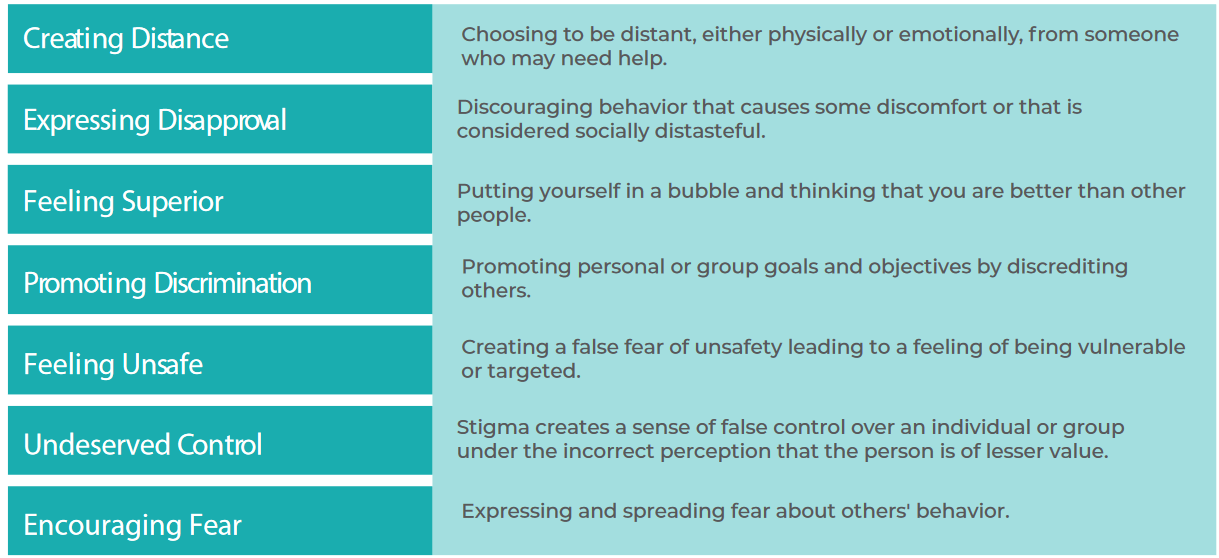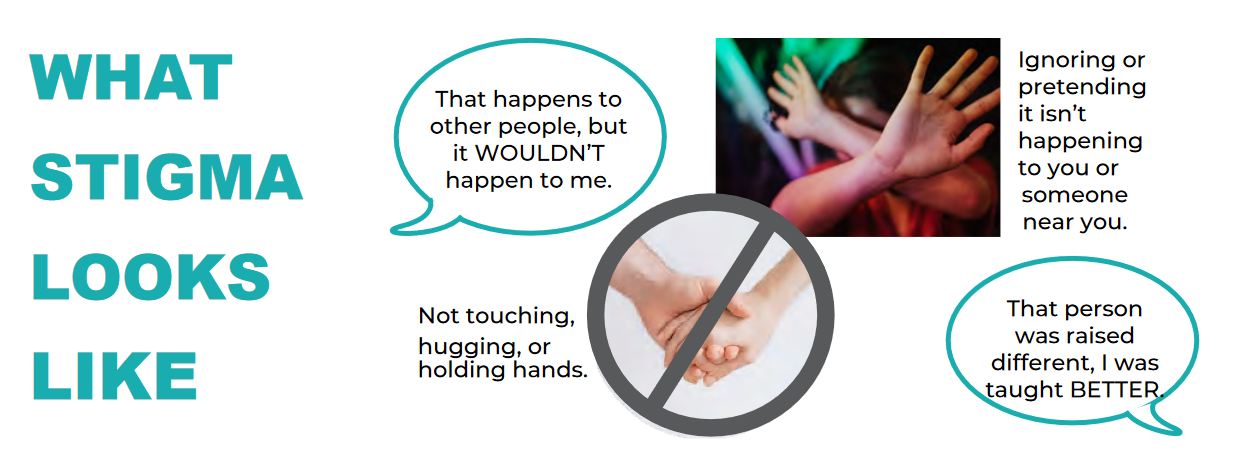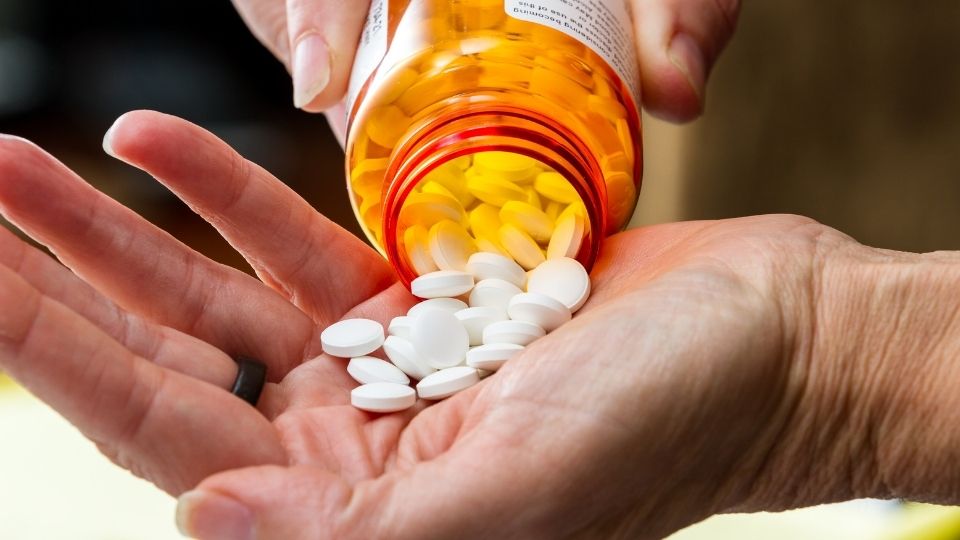Substance Use Disorder Stigma: What it is and How You Can Prevent it

Stigma is an attitude, discrimination, or prejudice directed towards an individual or a group and can prevent a person from seeking out proper care, support, and treatment (Angermeyer & Dietrich, 2006). Additionally, stigma can suppress essential evidence-based policy measures (Kennedy-Hendricks et. al., 2017; McGinty, Pescosolido, Kennedy-Hendricks, & Barry, 2018). Learn how you can make a difference.
Substance Use Disorder
Substance Use Disorder (SUD), is the repeated use of alcohol and/or drugs despite negative impacts or damages (American Psychiatric Association [APA], 2013), it is a highly stigmatized disease. In 2017, SUDs impacted nearly 20 million Americans aged 12 and older (Substance Abuse Mental Health Services Administration [SAMHSA], 2018). Of that, 1.7 million misused a pain killer (i.e. opioid) and 700,000 used heroin (SAMHSA, 2018).
Common forms of SUD include (SAMHSA, 2017):
- Alcohol Use Disorder
- Marijuana Use Disorder
- Opioid Use Disorder
How Individuals with SUD May Experience Stigma
Stigma can be a prejudice or discrimination; it can promote fear and shame; it can cause distrust or disgrace; it can lead to anger or frustration; it can exclude and deny rights, and it can reduce support for policies that would improve equitable treatment of this population (Landry, 2012; Barry, McGinty, Pescosolido, & Goldman, 2014; McGinty et. al., 2017).
There are three types of stigma: self, social, and structural. Self-stigma is characterized by negative feelings about one’s self, social stigma is characterized by groups boosting stereotypes of stigmatized people, and structural stigma is the negative attitudes and behavior of those that represent larger groups (Landry, 2012; Livingston, Milne, Fang, & Amari, 2012). Stigma towards individuals with SUD can look like any one or more of the following (Landry, 2012):

Substance Use Disorder is a Disease
Those with a SUD are negatively viewed because of the false characterization that the person chose to misuse substances, and thus, chose the addiction. Often they are wrongly perceived as bad or weak; unfit for society. Many of these negative attitudes are based on the fact that the person is addicted to an illegal substance and is breaking the law. In fact, Substance Use Disorder can begin with your doctor prescribing opioid medications (National Institute on Drug Abuse [NIDA], 2018). These negative feelings towards someone with a SUD can lead to discrimination at home, school, or work.

Steps You Can Take to Better Understanding SUD Stigma
Everyone is different. Each person’s path to using substances is unique. Examine your beliefs about why some people become addicted to substances.
Everyone is different. No single treatment is the answer to all SUDs. Treatment varies based on personality and personal preference. Examine your beliefs about treatment styles.
Everyone is different. Recovery is a process that patients with SUD often have to repeat. Examine your beliefs about recovery being a lifelong process.
Why Reducing Stigma Can Help
The importance of the person seems to become lost behind negative and harmful words. Stigmatization can leave someone feeling disvalued and even worthless. These feelings create barriers to seek help or to support someone who needs help (Ahern, Stuber, & Galea, 2007). Check out the back for actions you can take to combat stigma.
How to Support Someone with a SUD
If your loved one has a SUD:
Family and friends are often the first to notice someone is developing a SUD, due to changes in behavior, mood, or thoughts. When speaking with your loved one, it is important to act with empathy, compassion, and understanding of this medical condition. Stigma can prevent someone to openly talking about having a SUD, limit or restrict the person’s path to treatment, and in some cases, lead to death (Angermeyer & Dietrich, 2006).
- Be kind to yourself which may include therapy or other self-care strategies, it can be mentally and physically difficult to help a loved one with SUD.
- Treatment and recovery services are out there, know more about resources and referrals for when your loved one is ready.
- Spread the word! Continue educating yourself and others about SUD to reduce stigma.
How to talk with someone with a SUD (SAMHSA, 2017):
- Use words carefully, harmful words can trigger different emotions and lead to stigma
- Ask if they need support, talk to them with compassion and share your concerns.
Monitor Your Language & Thoughts to Reduce Stigma

Actions to Take to Reduce Stigma Toward Substance Use Disorders
| You can learn about prevention strategies (SAMHSA, 2018) | There are a number of things that contribute to a person developing SUD. Prevention strategies focus on reinforcing protective factors and decreasing risk factors that influence SUD. (SAMHSA, 2009). |
|---|---|
| You can learn about harm reduction strategies (UDOH, 2018) | Harm reduction strategies focus on reducing undesirable consequences that can come with substance use/misuse (e.g. viral infections, skin infections, overdose, etc) |
| You can learn about recovery (UDOH, 2018) | There is no "one-stop-shop" solution, recovery looks different for everyone and does not have to follow any timeline to be valid. Repeating treatment does not mean failure, and using terms that signal failure (i.e. "falling off the wagon") to describe someone's journey can be harmful. |
| You can speak out and share what you have learned | Implement the things you have learned in both personal and professional settings. You are in a position to teach others about stigma toward SUD and how to help reduce it |
References
- Ahern, J., Stuber, J., & Galea, S. (2007). Stigma discrimination and the health of illicit drug users. Drug and Alcohol Dependence, 88(2-3), 188-196. doi: 10.1016/j.drugalcdep.2006.10.014
- American Psychiatric Association. (2013). Diagnostic and Statistical Manual of Mental Disorders, Fifth Edition. Arlington, VA: American Psychiatric Association.
- Angermeyer, M.C., & Dietrich, S. (2006) Public beliefs about and attitudes towards people with mental illness: A review of population studies. Acta Psychiatrica Scandinavica, 113(3), 163-79. doi: 10.1111/j.1600-0447.2005.00699.x
- Barry, C.L., McGinty, E.E., Pescosolido, B.A., & Goldman, H.H. (2014). Stigma, discrimination, treatment effectiveness, and policy: Public views about drug addiction and mental illness. Psychiatric Services, 65(10), 1269-1272. doi:10.1176/ps.201400140
- Kennedy-Hendricks, A., Barry, C.L., Gollust, S.E., Ensminger, M.E., Chisolm, M.S., & McGinty, E.E. (2017). Social Stigma toward persons with prescription opioid use disorder: Associations with public support for punitive and public health-oriented policies. Psychiatric Services, 68(5), 462-469. doi: 10.1176/appi.ps.20160056
- Landry, M. (2012). Anti-stigma toolkit: A guide to reducing addiction-related stigma [PDF file]. Silver Spring, MD: American Psychiatric Press. Retrieved from http://pcssnow.org/wp-content/uploads/201/10/Anti-Stigma-Toolkit.pdf
- Livingston, J.D., Milne, T., Fang, M.L., & Amari, E. (2012). The effectiveness of interventions for reducing stigma related to substance use disorders: A systematic review. Addiction, 107:39-50. doi: 10.1111/j.1360-0443.2011.03601.x
- McGinty, E., Pescosolido, B., Kennedy-Hendricks, A., &Barry, C.L. (2018). Communication strategies to counter stigma and improve mental illness and substance use disorder policy. Psychiatric Services, 69(2), 136-146. doi: 10.1176/ps.201700076
- National Institute on Drug Abuse. (2018, January 17). Prescription opioids and h Retrieved from https://www.drugabuse.gov/publications/research-reports/prescription-opioids-heroin on 2018, October 10
- Substance Abuse and Mental Health Services Administration. (2017, November). Words matter: How language choice can reduce stigma. Retrieved from https://www.samhsa.gov/capt/sites/default/files/resources/sud-stigma-tool.pdf
- Substance Abuse and Mental Health Services Administration. (2017). Key substance use and mental health indicators in the United States: Results from the 2016 National Survey on Drug Use and Health (HHS Publication SMA 17-5044, NSDUH Series H-52). Rockville, MD, Center for Behavioral Health Statistics and Quality, Substance Abuse and Mental Health Services Administration. Retrieved from https://www.samhsa.gov/data/
- Substance Abuse and Mental Health Services Administration. (2018, August 13). Risk and Protective Factors. Retrieved from https://www.samhsa.gov/capt/practicing-effective-prevention/prevention-behavioral-health/risk-protective-factors
- Substance Abuse and Mental Health Services Administration. (2009). Risk and protective factors for mental, emotional, and behavioral disorders across the life Retrieved from https://dhss.alaska.gov/dbh/Documents/Prevention/programs/spfsig/pdfs/IOM_Matrix_8%205x11_FINAL.pdf
- Substance Abuse and Mental Health Services Administration. (2018). Key substance use and mental health indicators in the United States: Results from the 2017 National Survey on Drug Use and Health (HHS Publication No. SMA 18-5068, NSDUH Series H-53). Rockville, MD: Center for Behavioral Health Statistics and Quality, Substance Abuse and Mental Health Services Administration. Retrieved from https://www.samhsa.gov/data/
- Utah Department of Health. (2018). Harm reduction navigator training [PPT]. Salt Lake City, UT, Utah Department of Healt
Authors
Kandice Atisme, Ashley Yaugher, Mateja Savoie-Roskos, Reshma Arrington
Related Research























